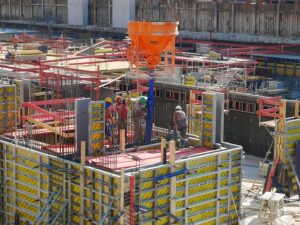Expert Inspection: Unlocking Residential Foundation Repair Secrets

Residential foundation repair requires thorough understanding of construction and environmental fact…….
In the realm of construction and infrastructure, the foundation is the bedrock upon which entire structures are built, literally and metaphorically. Foundation inspection, therefore, stands as a critical process that ensures the integrity, safety, and longevity of these foundations. This detailed article aims to dissect the intricacies of foundation inspection, exploring its historical roots, global practices, economic implications, technological innovations, regulatory frameworks, and future trajectory. By delving into these aspects, we will equip readers with a comprehensive understanding of why this process is essential and how it shapes our built environment.
Definition: Foundation inspection involves the thorough examination of the structural elements that support a building or infrastructure project. It includes assessing the condition of foundations, basements, footings, and any associated structural components to ensure they meet safety standards and regulatory requirements.
Core Components:
Visual Inspection: This is the initial step where inspectors visually assess the foundation for any visible defects, cracks, water damage, or signs of corrosion. It involves a detailed walk-through examination.
Non-Destructive Testing (NDT): NDT methods are employed to evaluate the structural integrity without causing damage. Techniques include ground penetration radar (GPR), ultrasonics, and electromagnetic testing.
Soil Analysis: Understanding the soil conditions surrounding the foundation is vital. Soil tests help assess stability, moisture content, and potential settlement issues.
Structural Calculations: Engineers perform calculations to verify that the foundation design is adequate for the applied loads and local building codes.
Historical Context: The practice of foundation inspection has evolved over centuries, driven by advancements in construction techniques and an increasing awareness of structural safety. Ancient civilizations relied on empirical knowledge and basic engineering principles, while modern practices benefit from sophisticated technology and scientific understanding. Today, rigorous foundation inspection protocols are mandated by most regulatory bodies to prevent catastrophic failures.
Foundation inspection is a universal requirement in construction, but its implementation varies globally due to differing cultural, environmental, and economic factors. Here’s an overview:
| Region | Practice and Trends | Unique Considerations |
|---|---|---|
| North America | Stringent regulations with advanced NDT techniques. Regular inspections are mandatory for new construction and renovations. | Emphasis on seismic safety due to active fault lines. |
| Europe | Comprehensive inspection protocols, especially in historic cities. Digitalization is transforming the process with drone surveys and 3D modeling. | Varied soil conditions across countries impact foundation design and inspection. |
| Asia-Pacific | Rapid urbanization drives intense construction activity. Foundation inspections are gaining importance as a result, but standardization lags in some countries. | Climate change impacts ground stability, requiring specialized testing methods. |
| Middle East | Strict adherence to international standards with a focus on desert-specific foundation designs. | High temperatures and arid conditions present unique challenges for material longevity. |
| Africa | Variable inspection practices due to resource constraints. Growing awareness of safety standards is encouraging better practices. | Local building codes are emerging, but standardization remains a work in progress. |
The economic aspects of foundation inspection are multifaceted and have significant implications for the construction industry.
Market Dynamics:
Investment Patterns:
Economic Impact:
Technological innovations have revolutionized foundation inspection, enhancing efficiency, accuracy, and safety.
Current Technologies:
Drone Surveys: Unmanned aerial vehicles (UAVs) equipped with high-resolution cameras and LiDAR sensors provide rapid and detailed 3D models of structures and surrounding areas. This technology aids in visual inspections, especially in hard-to-reach locations.
Ground Penetrating Radar (GPR): GPR uses electromagnetic waves to create images of underground structures and anomalies, helping identify cracks, voids, and other defects without disturbing the surface.
Ultrasonic Testing: This method sends high-frequency sound waves through materials to detect internal flaws or cracks. It is particularly useful for non-metallic materials like concrete.
Digital Data Management: Cloud-based platforms facilitate secure data storage, sharing, and collaboration among inspection teams, engineers, and stakeholders.
Future Potential:
Government agencies and professional bodies play a pivotal role in shaping the landscape of foundation inspection through policies, regulations, and standards.
Key Regulatory Bodies:
International Organization for Standardization (ISO): ISO 14737 provides guidelines for the inspection of concrete foundations and structures. It offers a comprehensive framework for various types of inspections.
American Society of Civil Engineers (ASCE): ASCE publishes the “Foundation Inspection Manual,” offering practical guidance for inspectors in North America and beyond.
Local Building Departments: These agencies enforce building codes, including foundation design and inspection requirements specific to their regions.
Regulatory Trends:
Stricter Safety Standards: Many countries are adopting more rigorous safety standards due to increasing awareness of structural failures’ catastrophic consequences.
Digitalization Requirements: Some jurisdictions mandate the use of digital tools for data collection, documentation, and reporting in foundation inspections.
Green Building Initiatives: There is a growing emphasis on environmentally friendly practices, influencing foundation design and inspection protocols.
Foundation inspection is an essential process that ensures the safety and longevity of built structures. The global trend towards stringent regulations, technological advancements, and economic considerations underscores its importance. As construction continues to evolve, so must the methods and standards for foundation inspection to meet the demands of a dynamic world.

Residential foundation repair requires thorough understanding of construction and environmental fact…….

Residential foundation repair is essential for structural integrity and safety. Early signs of found…….

Residential Foundation Repair is essential for home structural integrity and longevity. Signs of fou…….

Residential Foundation Repair starts with a comprehensive inspection using tools like moisture meter…….

Residential foundation repair is crucial for home maintenance, addressing issues like settlement, pr…….

Residential foundation repair ensures home stability and value through proactive inspection and targ…….

Residential foundation repair is essential for maintaining home safety and stability. Soil movement…….

Non-Invasive Foundation Inspections (NIFIs) leverage advanced technologies like ground-penetrating r…….

The foundation is a critical but often overlooked component of residential structures, providing ess…….